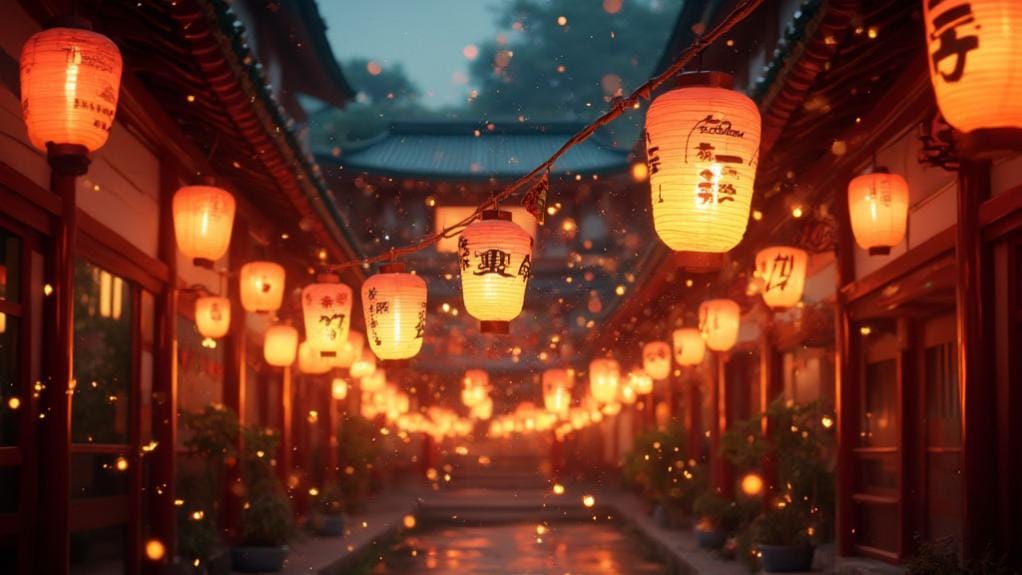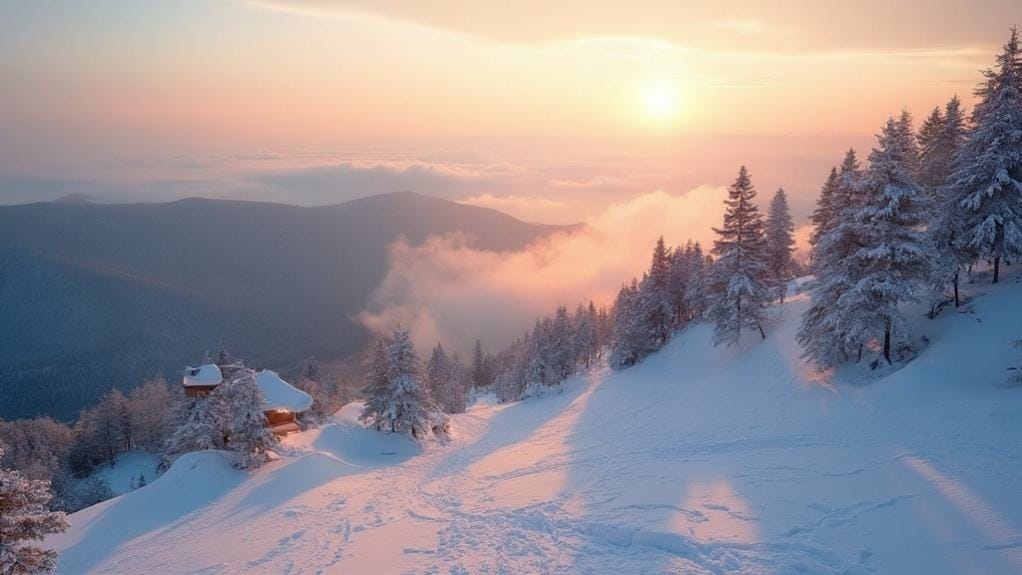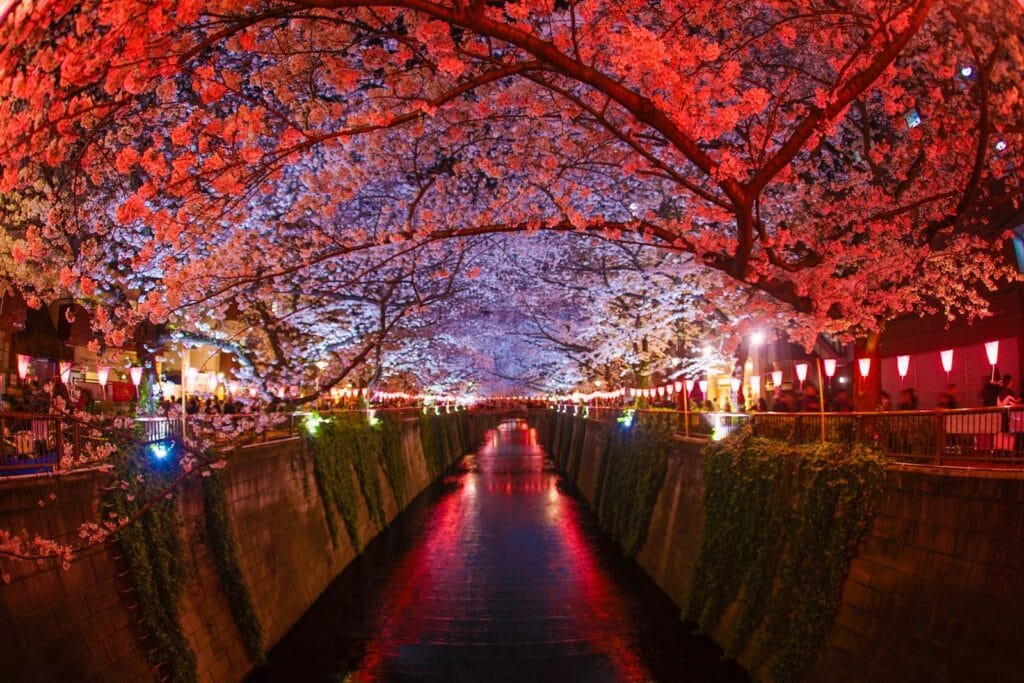I’d say the ideal time to visit Japan depends on what experiences you’re seeking. Spring (March-May) dazzles with cherry blossoms but draws crowds, while autumn (September-November) offers comfortable temperatures and stunning fall foliage with fewer tourists.
Summer brings vibrant festivals but can be humid, with typhoon risks from May to October. Winter’s perfect for skiing in Hokkaido, though temperatures can plunge to -25°C up north while Okinawa stays mild.
I’ve found that October hits the sweet spot – you’ll get pleasant weather, cultural celebrations like Culture Day, and those magnificent autumn colors. There’s much more to discover about each unique season’s special charm.
Weather Patterns Throughout the Year
If you’re planning a trip to Japan, understanding its seasonal weather patterns is essential for choosing the best time to visit.
I’ve experienced firsthand how dramatically the climate shifts throughout the year, from spring’s gentle warmth to summer’s intense humidity.
You’ll find spring temperatures hovering between 12-18°C, making it ideal for outdoor exploration, though you’ll want to pack layers.
Summer brings the heat, with temperatures soaring to 31°C, along with the challenges of typhoon season and heavy rainfall.
Fall offers a sweet spot of comfort, with temperatures ranging from 17-22°C, though you’ll need to watch for late-season typhoons.
Winter’s a tale of two experiences – you’ll encounter frigid temperatures as low as -25°C up north in Hokkaido, while southern regions like Okinawa stay surprisingly mild. The Tohoku region transforms into a stunning winter wonderland, perfect for snow-seeking adventurers.
Savvy travelers can make the most of low season rates by visiting during winter months when tourism typically drops.
Cherry Blossom Season Visitor Guide
A sea of pink petals transforms Japan during cherry blossom season, drawing millions of visitors between late March and early April.
If you’re planning to catch this stunning natural display, I’d recommend timing your visit for early April, when most major cities reach full bloom.
You’ll find Tokyo’s blossoms typically peak around April 1st, while Kyoto and Osaka follow a few days later. When fall arrives, Kyoto’s autumn foliage colors create an equally mesmerizing spectacle.
For the quintessential hanami experience, I suggest heading to Tokyo’s Ueno Park, where you can join locals picnicking under more than 1,000 cherry trees.
If you’re seeking a more peaceful viewing, you’ll love the serene atmosphere of Chidori-ga-fuchi’s boat rides or the quiet paths of Aoyama Cemetery.
Don’t forget to sample seasonal sakura-flavored treats while you’re exploring – they’re part of the magic!
In Kyoto, the ancient cherry trees create particularly memorable viewing spots that showcase the city’s historic charm.
Summer Festivals and Events

While spring brings cherry blossoms, summer in Japan bursts with vibrant festivals that showcase the nation’s rich cultural heritage.
I’ve found July and August to be particularly spectacular, with the legendary Gion Matsuri in Kyoto filling the streets with magnificent floats and traditional performances. The Yoiyama festivities include dazzling evening parades through Kansai’s ancient capital.
You won’t want to miss the Sumida River Fireworks Festival in Tokyo, where over 20,000 fireworks illuminate the night sky in a dazzling display that’ll take your breath away.
If you’re looking for something truly unique, I’d recommend heading to Tokushima for the Awa Odori Dance Festival, where you can join over 100,000 dancers in their mesmerizing traditional movements.
For a spiritual experience, time your visit with the mid-August Obon Festival, when lanterns light up temples and the haunting sounds of traditional drums fill the air.
The 2024 festival calendar offers an exceptional opportunity to experience Japan’s most cherished cultural celebrations firsthand.
Fall Foliage Travel Planning
Timing your visit perfectly, autumn in Japan transforms the landscape into a spectacular canvas of red, orange, and gold.
I’ve found that planning your foliage viewing requires strategic timing based on region and elevation.
| Region | Peak Time | Must-Visit Spots |
|---|---|---|
| Northern Japan | Late Sept – Early Oct | Hokkaido’s national parks |
| Central Japan | Mid-Oct – Nov | Takayama, Nikko |
| Southern Japan | Nov – Early Dec | Kyoto temples, Nara Park |
| Urban Areas | Late Nov – Dec | Tokyo parks, Osaka gardens |
You’ll want to book accommodations at least six months ahead, especially in popular spots like Kyoto and Hakone.
I recommend packing layers and comfortable walking shoes – you’ll be doing plenty of exploring! Setting a daily budget plan helps ensure you can fully enjoy seasonal activities without financial stress.
Don’t forget to warm up with seasonal treats like roasted sweet potatoes while you’re taking in nature’s show.
Many of Japan’s most breathtaking gardens offer stunning displays of autumn colors against traditional landscaping.
Winter Sports and Activities

Japan’s winter sports scene transforms the country into a powdery paradise from late December through mid-March.
For those seeking ultimate luxury experiences, Japan’s high-end ski resorts offer exclusive amenities and private instruction from world-class coaches.
I’d recommend targeting mid-January to mid-March for the best experience, when you’ll find shorter lift lines and better deals on accommodations.
If you’re like most visitors, you’ll want to head to Hokkaido’s renowned resorts, where pristine powder and world-class facilities await.
While skiing dominates the winter sports landscape (a whopping 80% of Japanese men have tried it!), you’ll find plenty of alternatives.
I particularly love snowshoeing at Mount Kirigamine, where you can escape the crowds and immerse yourself in serene winter landscapes.
The Chubu region resorts offer excellent alternatives to Hokkaido’s popular destinations, with stunning mountain vistas and diverse terrain options.
After a day on the slopes, don’t miss soaking in an onsen – there’s nothing quite like melting away your muscle aches in a steaming hot spring.
Navigating the Rainy Season
The rainy season in Japan presents unique challenges and opportunities for travelers between early June and mid-July. While you’ll encounter higher humidity and frequent downpours, I’ve found this period offers unexpected advantages for savvy visitors.
You’ll discover considerably lower prices on accommodations and fewer crowds at major attractions.
I recommend embracing indoor cultural experiences during wet weather – imagine learning the art of bonsai while rain drums peacefully outside, or watching master craftsmen forge katanas in traditional workshops.
Don’t miss the stunning hydrangea blooms that carpet temple grounds and gardens; these beautiful flowers actually thrive in the rainy conditions. When skies clear temporarily, consider taking a day trip to Lake Saiko for its serene mountain views and traditional attractions.
If you’re visiting the Kanto region, you can expect the wettest period from June 8 to July 21, though I’ve noticed the weather patterns can be quite unpredictable.
If the rain clears during your visit, consider taking your family to Mount Fuji’s base for outdoor adventures and stunning photography opportunities.
Peak Tourist Seasons

Understanding Japan’s peak tourist seasons can make or break your travel experience.
I’ve found that spring (March-May) draws the largest crowds, with cherry blossoms and Golden Week festivities creating a magical but hectic atmosphere. If you’re seeking a more balanced experience, I’d recommend autumn (September-November), when you’ll encounter fewer tourists while still enjoying spectacular fall colors and pleasant temperatures.
Winter’s peak primarily centers around the December holidays and January ski season, though you’ll find it’s particularly quieter outside these specific periods.
I always warn my travelers about two other essential peak times: August’s Obon Festival and Golden Week in late April through early May. During these periods, you’ll compete with both international visitors and domestic travelers for accommodations and transportation, so you’ll want to book well in advance.
October has become increasingly busy in recent years, with 2.5 million visitors recorded in Kyoto alone during this month in 2023.
In Fukuoka specifically, planning your visit during January-February offers the advantage of smaller crowds while still allowing you to explore major attractions like the historic Kushida Shrine and Fukuoka Castle ruins.
Regional Weather Differences
From north to south, Japan’s diverse climate zones create distinctly different travel experiences throughout the year.
I’ve found that Hokkaido’s winters are breathtakingly crisp, with temperatures plunging to -20°C inland, while Okinawa stays comfortably mild even in December.
You’ll notice dramatic contrasts between the Pacific and Sea of Japan sides too.
If you’re visiting central regions like Tokyo or Kyoto, you’ll enjoy more moderate conditions, though summer’s humidity might catch you off guard.
I always tell travelers to pack accordingly – what works in Sapporo won’t cut it in Fukuoka!
The Seto Inland Sea region offers some of the most pleasant weather year-round, while the southern regions must contend with early summer monsoons and occasional typhoons, particularly during August’s peak.
Okinawa’s subtropical climate ensures warm temperatures and beach-friendly conditions nearly year-round.
Before traveling, remember to check current exchange rates to budget effectively for your seasonal activities.
Typhoon Season Travel Tips
Planning ahead during Japan’s typhoon season requires careful attention to weather forecasts and flexible travel arrangements.
I’ve found that it’s vital to stay informed and prepared between May and October, particularly during the peak months of August and September.
| Essential Tips | Indoor Activities | Safety Measures |
|---|---|---|
| Monitor weather apps | Visit museums | Pack emergency kit |
| Book flexible tickets | Explore malls | Follow authorities |
| Check transport updates | Tour temples | Stay connected |
When I travel during typhoon season, I always make sure I’ve got a backup plan for my itinerary.
You’ll want to keep an emergency kit handy with essentials like water, non-perishable food, and important documents. I recommend downloading reliable weather apps and following local media for real-time updates.
If you’re caught during a typhoon, remember that most Japanese businesses and accommodations will help you reschedule without penalties.
For peace of mind when traveling through Japanese airport terminals, familiarize yourself with the evacuation procedures and emergency exits before your journey.
Following local safety guidelines is crucial for maintaining personal security during your stay in Japan.
Cultural Celebrations Calendar
Japan’s cultural calendar bursts with vibrant festivals and celebrations throughout the year, making it essential to align your travel dates with the events you’d like to experience.
I’ll help you navigate the highlights of each season to maximize your cultural immersion.
Spring brings the iconic cherry blossom festivals, while summer dazzles with the romantic Tanabata Star Festival and the spectacular Tenjin Festival’s floating processions.
The northern Tohoku region festivals offer some of Japan’s most spectacular summer celebrations, drawing visitors from around the world.
If you’re visiting in autumn, I highly recommend timing your trip to catch Culture Day on November 3rd, when museums offer free admission and traditional performances fill the streets.
Winter transforms Japan into a wonderland, particularly during February’s Sapporo Snow Festival, where master artists carve intricate sculptures from pristine ice and snow.
You won’t want to miss the spiritual energy of New Year’s celebrations, when temples ring their bells 108 times to welcome the year ahead.
Art enthusiasts can enhance their cultural experience by visiting Japan’s top art museums which showcase both traditional Japanese masterpieces and contemporary works.




